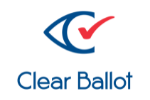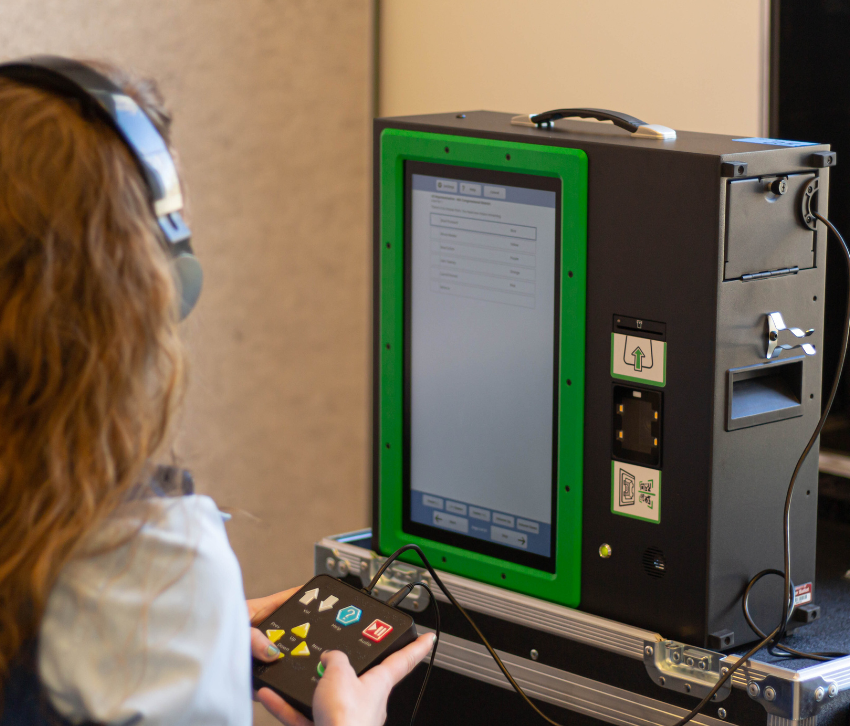Clear Ballot: Ensuring that every vote — and every voter — counts


The Client:
Clear Ballot, founded in 2009, is dedicated to providing election officials with products and services that help them run great elections. It began as an audit company focused on increasing transparency in elections, grew to helping counties run vote-by-mail elections, and expanded to providing equipment that voters use in the polling place.
The Challenge:
Clear Ballot is committed not just to digital accessibility, but to overall accessibility in voting.
Clear Ballot’s Vice President of Product, Helen Michaud, is responsible for finding ways to constantly improve the company’s products while considering the changing needs of customers — from election administrators and poll workers to the voters themselves.
“Software plays a large role in our products, but what voters are interacting with is a voting device that is made up of our custom hardware and proprietary software,” she said. “Ensuring that these devices are accessible is essential as it is a cornerstone of our democracy to ensure that everyone has the ability to cast their vote independently, privately, and with confidence.”
One of the components of Clear Ballot’s full voting system is an accessible ballot marking device designed to help voters with disabilities go through each contest on the ballot and register their votes — including write-in votes — easily and independently.
The company’s latest iteration of a ballot marking device, called ClearMark, was designed and built from scratch, representing a major update to previous offerings. And it was critical to Clear Ballot to test the product in conditions as close to the real world as possible with voters of varying abilities and backgrounds to ensure that each and every vote would count.
The Solution:
Clear Ballot and Perkins Access had worked together previously, so when the company needed a partner for accessibility and usability testing, the choice was clear.
Michaud said, “For this project, we didn’t consider any vendors other than Perkins Access. Aside from the fact that they’re renowned for their expertise locally and nationally, we had such a great experience in previous projects that re-engaging was a no-brainer. Having a team that was familiar with us as a company, our products, and our use cases was an immeasurable benefit.”
To test ClearMark, Perkins Access hosted a mock election over the course of three days, giving Clear Ballot the opportunity to get feedback from voters of all kinds — including people with and without disabilities, English speakers and non-native speakers alike.
The simulated polling location was an end-to-end voting experience where participants checked in, were escorted to the voting station, voted and cast ballots. Once participants had completed the testing process, they were debriefed in an exit interview with the Perkins Access team.
Participants were asked to share why accessible voting is important to them, and Kim Charlson, Executive Director of Perkins Library, said: “Voting is a fundamental right for every citizen of the U.S. over the age of 18. It should be something that’s equally available to all, regardless of ability. Being able to cast a ballot independently, privately, and securely is critical to ensuring that anyone with a disability has the opportunity to participate fully in our democratic process.”
When the mock election concluded, Perkins Access created a comprehensive report that detailed the participants’ encounters, summarized the results and offered recommendations for enhancing the voter experience. Clear Ballot used this report not only to drive improvements in the product, but also to fulfill certification requirements at the state and federal level.
“The mock election was amazing — I wish all polling places were like this,” Michaud said. “We very much appreciated the meticulous care taken with every part of the process, from planning to execution of the testing to the final report. The Perkins Access team did a terrific job walking us through the steps from start to finish.”
She continued, “Being able to witness the testing, reinforced that even when you design with best practices in mind, there’s no substitute for seeing the product in action. We were also reminded that there is always room for improvement even in areas where the functionality we tested was very similar to previous releases — and we were able to make specific enhancements based on the feedback.”
In fact, the ClearMark team took away several targeted improvements they were able to incorporate into the initial version of the product, as well as some larger themes to address in future releases. And Michaud observed that, while attending the mock election, several members of the Clear Ballot team developed a greater appreciation for the specific challenges that voters with disabilities face — an experience that will stay top-of-mind as they continue to develop their product.
The Outcome:
The results of the testing were impressive: 100% of voters were able to cast their ballots, and the mean accuracy of voters in completing the 20 core tasks improved from Clear Ballot’s previous testing to 92.92% overall.
Gary Aussant, Director of Perkins Access Consulting, led the mock election and described the value of user testing: “There is nothing like being able to observe real people as they attempt to use your product for what it is intended for. You can see first hand what works well and what can be improved. In the case of the ClearMark system, we saw a lot of things working well but we were still able to give the team at Clear Ballot a list of suggestions that would make the system even more accessible and usable.”
Michaud appreciates the contributions of the users who participated in the mock election. “It was gratifying to see how many people volunteered for the study because they felt it was important — and it felt good to engage with the community to make sure their voices are heard.”
Ultimately, though the usability and accessibility testing added another layer to the development of the ClearMark product, Michaud doesn’t underestimate the value of the process.
“While it’s important for us to ensure that our system works for all voters, we don’t always get the chance to see voters with disabilities interacting with our equipment, especially in an environment where we’re able to observe and get their feedback,” she said. “This was an invaluable opportunity to invite a number of users to complete the same task and to see the results — both objectively in terms of success metrics and subjectively in terms of their satisfaction with the product.”
She concluded, “This project took time and effort, but it was well worth the investment. The Perkins Access team is top notch, generous with their expertise, and wonderful to work with. I wholeheartedly recommend working with them.”
Share this Story
Ready to talk to an expert about your accessibility issues?

